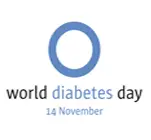 World Diabetes Day, November 14th, aims to increase diabetes awareness among individuals and provide better resources, so that everyone has access to a better diabetes care system and each individual is better educated about the complications and risks associated with diabetes.
World Diabetes Day, November 14th, aims to increase diabetes awareness among individuals and provide better resources, so that everyone has access to a better diabetes care system and each individual is better educated about the complications and risks associated with diabetes.
Access to diabetes care is the theme for the World Diabetes Day 2021 – 2023.
Insulin was developed in the year 1921 and healthcare professionals were able to save millions of lives using therapeutic insulin since then, but diabetic care and management system are still beyond reach for majority of people.
The International Diabetes Federation (IDF) represents the global diabetes community with an endeavor to promote diabetes awareness and improve access to diabetic care. “Know your risk, know your response”, the slogan for world diabetes day, 2023 was coined to create general awareness about the complications arising from diabetes and how the complications can be minimised.
Diabetes is among the top noncommunicable diseases (NCDs). It is a condition wherein pancreas fails to make enough insulin, or the body fails to use insulin effectively. This leads to high blood glucose levels and high blood glucose over a long time leads to numerous lethal health complications.
Generally, diabetes can be classified into three types
- Type 1: Where the pancreas makes less insulin or fails to make insulin. Those diagnosed with Type – 1 diabetes need regular insulin treatment and glucose monitoring. This cannot be prevented
- Type 2: Body resists insulin consequently leading to increased blood glucose levels or body secrets very less insulin. This is the most common type of diabetes and affects the majority of the population. Type 2 diabetes is an easily avoidable condition.
- Gestational Diabetes: Gestational diabetes occurs during pregnancy and usually resolves after birth. Both mother and baby are affected during gestational diabetes, and it can also lead to birth related complications.
The most common symptoms of diabetes include abnormal thirst and dry mouth, frequent urination, lethargy, blurred vision and tingling or numbness in feet.
With a major percentage of the population becoming tech savvy and being aware of health, people with diabetes are now more educated and risk conscious nowadays. Yet, research suggests that about 40% of the diabetic population are unaware of their condition and are undiagnosed.
A lot of countries have National diabetes policies to prevent and manage diabetes, but the policies do not bring expected outcomes because of either not being implemented properly or because of paucity of funds. Many developing countries have limited or insufficient resources to even educate people about diabetes. Access to diabetes care (Theme for the World Diabetes Day 2021 – 2023) thus aims to make insulin and other essential diabetic medicines accessible.
WHO Global Diabetes Compact, launched by WHO and the Government of Canada plans to reduce diabetes and provide access to affordable diabetic care. The compact is also supported by the University of Toronto.
Research Statistics:
- According to collaborative research by International Diabetes Federation, Baker Heart and Diabetes Institute and Ajou University School of Medicine; there will be 690 million people with diabetes worldwide by 2045. The research also discloses that about 40% of the diabetic population right now are undiagnosed.
- Some more statistics from the International Diabetes federation suggest that there were about 530 million adults living with diabetes, in the year 2021.
- About 6.7 million people died of complications arising from diabetes in 2021
- The condition also is responsible for an approximate $960 billion health expenditure.
- The Madras Diabetes Research Foundation et al, conducted a study across 31 states in India for people aged above 20, during the period 2008 – 2020. The statistics from the study reveal that diabetes prevalence had increased exponentially and may have serious effects on population health.
Treatment for Diabetes had evolved considerably over time. Most common treatment and monitoring systems are,
- Continuous glucose monitoring: Helps to review glucose levels throughout the day. CGM calculates and stores the blood glucose levels data. While some CGMs need a scan from the receiver or a smartphone every few hours to get data, real time CGMs display the data instantly. CGMs usually have 3 parts, the sensor (placed underneath the skin or implanted), transmitter (to send the data – blood glucose levels) and the receiver. Data receiver can be an app on the smartphone which displays the blood glucose data range over time. CGM is beneficial because it can send alert warnings about very low or high blood glucose levels, and it also provides practical information about how the food we eat directly influences the blood glucose levels.
- Medicines: Although many medicines have been available to treat diabetes for a long time, modern targeted medicines can minimize the side effects associated with the conventional medications. Some examples are Sulfonylureas (SFUs), SGLT2 inhibitors, DPP-4 inhibitors, GLP-1 analogs, Thiazolidinediones, Alpha-glucosidase inhibitors, Biguanides etc,.
- Insulin Pumps: Pumps are devices that deliver insulin steadily throughout the day. The dosages can be customized to deliver some extra insulin during meals. Pumps are user friendly as they are customizable in terms of dosage. There are two forms of dosage for insulin pumps, basal and bolus. Basal insulin, also known as background insulin, is the continuous dosage of small and specified amounts of insulin throughout the day. Bolus insulin is a little extra dosage of insulin administered during mealtime. Bolus amount is usually specified based on the carbohydrate intake of a user and is calculated by the Insulin to carb ratio. Convention insulin pumps had infusion sets and an insulin pump separately that could be worn over the body. Insulin pumps have now evolved into being tubeless and non-invasive also.
- Insulin pens: Insulin pens are easy to use to inject insulin and provide customized dosage with a provision of continuous glucose monitoring. Pens are advantageous over conventional syringes and are usually injected into the abdomen part. For some insulin pens users can hear audible clicks while dosing. Insulin pens can also store user data such as last dosage and time. Insulin pens are usually of two types, pre-loaded and cartridge system. Pre-loaded or pre-filled pens are of unitary use and are disposable. The cartridge system pens, also called reusable insulin pens, have a replaceable insulin cartridge. Once the cartridge is empty, users can replace it with a new one. Reusable pens can also be configured to be connected to CGMs or a smartphone app to monitor and store blood glucose levels. Some examples of prefilled and reusable insulin pens are: FlexPen®, NovoPen®, ADMELOG SoloStar, BASAGLAR KwikPen, Autopen etc,.
A significant point to be noted is that there are a lot of generalized uncertified diabetes reversal programs available online these days with no proven records and no proper clinical trial records. People should be aware to not to fall prey to all these.
With all these treatments at place, as the slogan for the world diabetes day 2023, “Know your risk, know your response” indicates, being risk aware and responding on time to the risks is essential for a healthy life.
Conclusion: People with diabetes can develop serious health issues at any stage of life. Assessing the risk factors and monitoring blood glucose levels periodically is necessary to minimise diabetes risk. These risks can also minimised by creating general awareness among the public by implementing policies, conducting frequent awareness sessions etc,.
As we expect the governments and health authorities to implement the policies, general awareness and basic diabetic education is also expected from each and every individual for a healthy population. Diabetes, type 2 in specific, is a preventable disease and can be managed well with proper awareness.
According to numerous experts and research, personalized diabetic care and management model along with healthy diet and blood glucose control gives the best output.
References:
- https://worlddiabetesday.org/about/
- Diabetes stats: https://diabetesatlas.org/data/en/country/93/in.html
- https://www.thelancet.com/journals/landia/article/PIIS2213-8587(23)00119-5/fulltext
- https://journals.lww.com-Evaluation_of_Madras_Diabetes_Research.3.aspx
- https://diabetesatlas.org/data/en/country/93/in.html
- https://idf.org/who-we-are/about-idf/
- https://www.un.org/sustainabledevelopment/sustainable-development-goals/
- https://www.sciencedirect.com/science/article/abs/pii/S1357303918302627
- https://www.liebertpub.com/doi/full/10.1089/pop.2015.0181
- https://journals.lww.com-WHO_Global_report_on_diabetes__A_summary.2
- https://journals.lww.com-WHO_Global_report_on_diabetes__A_summary.2
- https://pubmed.ncbi.nlm.nih.gov/20609967/
- https://pubmed.ncbi.nlm.nih.gov/26111994/
- https://iris.who.int/bitstream/handle/10665/204871/9789241565257_eng.pdf?isAllowed=y&sequence=1
- https://worlddiabetesday.org
- https://www.cdc.gov/diabetes/data/statistics-report/index.html
- https://diabetesresearch.org/press-releases/
- https://diabetesresearch.org/diabetes-statistics/
- https://diabetesresearch.org/wp-content/uploads/2022/05/national-diabetes-statistics-report-2020.pdf
- https://www.sciencedirect.com/journal/diabetes-research-and-clinical-practice
- https://www.sciencedirect.com/science/article/abs/pii/S0168822723007489
- https://www.thehindu.com/sci-tech/health/31-million-more-indians-became-diabetic-between-2019-2021-says-study/article66949970.ece
- https://diabetesatlas.org/data/en/country/93/in.html
- https://www.everydayhealth.com/type-2-diabetes/advancements-that-have-changed-type-2-diabetes-treatment-and-management/
- https://www.ncbi.nlm.nih.gov/pmc/articles/PMC3498849/
- https://www.fda.gov/consumers/minority-health-and-health-equity-resources/diabetes
- https://www.novonordisk.com/our-products/smart-pens/novopen-6.html
- https://www.medtronicdiabetes.com/products/inpen-smart-insulin-pen-system
- https://www.dexcom.com/g6-cgm-system
- https://www.emperra.com/en/esysta-product-system/pen/
- https://pendiq.com/en/insulin-pen/
- RAni therapetuics – Rani pill – working on Insulin delivery
- https://www.ranitherapeutics.com/pipeline/
- https://myceqursimplicity.com/
- https://www.niddk.nih.gov/health-information/diabetes/overview/diet-eating-physical-activity
- https://www.novonordisk.com/our-products/pens-and-needles/novopen-5.html
- https://consumerguide.diabetes.org/collections/insulin-pens/products/admelog-solostar

